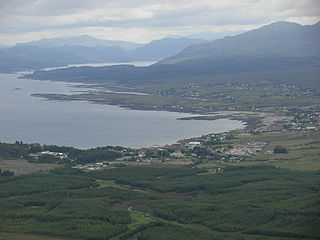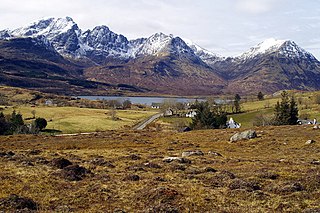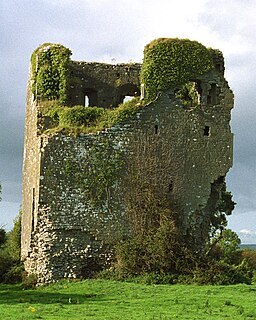
Kyleakin is a village situated on the east coast of the Isle of Skye in the Inner Hebrides, Scotland. The village is along the strait of Kyle Akin opposite the northwest Scottish mainland town of Kyle of Lochalsh. Kyleakin is within the parish of Strath.

Broadford, together with nearby Harrapool, is the second-largest settlement on the Isle of Skye, Scotland. Lying in the shadow of the Red Cuillin mountains, Broadford is within the parish of Strath. A long meandering village historically consisting of a few buildings on either side of the Broadford River, the many small townships around the wide sweep of the bay have grown together and Broadford now stretches for 1 1⁄2 miles around the southern side of Broadford Bay.

Torrin is a settlement on the island of Skye in Scotland.

Boreraig is a deserted township in Strath Swordale on the north shore of Loch Eishort in the parish of Strath, Isle of Skye, Scotland.

St Patrick's Chapel is a ruined building that stands on a headland above St Peter's Church, in Heysham, Lancashire, England. It is recorded in the National Heritage List for England as a designated Grade I listed building, and is a Scheduled Ancient Monument.

Dun Ringill is an Iron Age hill fort on the Strathaird peninsula on the island of Skye, Scotland. Further fortified in the Middle Ages, tradition holds that it was for several centuries the seat of Clan MacKinnon. It is located east of Kirkibost on the west shore of Loch Slapin.

Corriechatachan is a farmstead, lying at the foot of Beinn na Caillich, near Broadford, on the Isle of Skye. Until the 19th century, it was a tack farmed by a cadet branch of the Clan Mackinnon. Notable visitors included Thomas Pennant, in the course of the travels that resulted in the publication of A Tour of Scotland in 1769, and Samuel Johnson and James Boswell, on their tour of the Highlands.

Kilmarie or Kilmaree, is a village in the Isle of Skye, Scotland. Its most notable feature is the village church and graveyard. The graveyard has a significant number of tombstones from highland clans, in particular Clan MacKinnon. Nearby is Kilmarie House, former residence of Jethro Tull member Ian Anderson.

All Saints' Church, Newchurch is a parish church in the Church of England located in Newchurch, Isle of Wight, England. The church is medieval dating from the 13th century. In 1883, restoration of the church was carried out by A.R. Barker, at the instigation of the vicar Rev. Alfred Dicker.

Kilbride is a small township in Strath Swordale, Isle of Skye, Scotland.
The Reverend Neil Mackinnon was the first Protestant minister on the island of Skye, being for many years in the 17th century the Episcopalian minister of first Strath and subsequently Sleat.

Tomfinlough is a civil parish in County Clare, Ireland. A Christian establishment was first made here around 540 AD. The parish lands were often raided by Irish, Viking, Norman and English forces in the years that followed. The church was allowed to fall into ruins during the period when the Catholic Church was penalized in Ireland.

Dysart and Ruan is a Catholic parish in County Clare, Ireland. It covers the civil parishes of Ruan and Dysert, and includes the village of Ruan, which holds the parish office. The parish contains the ruins of the 12th century St. Tola's Church, part of Dysert O'Dea Monastery.

Killeely is a civil parish that lies partly in County Clare and partly in County Limerick in Ireland.

Killuran is a civil parish in County Clare, Ireland. It contains the village of O'Callaghans Mills. It is united with the civil parish of Kilkishen in the Catholic parish of O'Callaghans Mills.

Killilagh or Killeilagh is a civil parish in County Clare, Ireland. It contains the village of Doolin.

Inagh and Kilnamona is a parish of the Roman Catholic Diocese of Killaloe in County Clare, Ireland. It is mostly coterminous with the civil parishes of Inagh and Kilnamona that lie to the west of the county town of Ennis in the ancient barony of Inchiquin. The parish contains two churches and an oratory. Inagh-Kilnamona GAA club is situated in the eastern part of the parish.

Broadford Parish Church, Skye is a parish church in the Church of Scotland in Broadford, Skye.
The Very Rev William MacKinnon (1843–1925) was a 19th/20th-century minister of the Free Church of Scotland who served as Moderator of the General Assembly in 1908/09.

St Rufus Church, also known as Keith Parish Church, is a Church of Scotland church in Keith, Moray, that was built in 1816. Designed by James Gillespie Graham in the Perpendicular Gothic style, it has crenellated walls, traceried windows and a tall bell and clock tower at its west end. The doorway leading into the nave from the entrance lobby is an unusual war memorial, listing the names of parishioners who died in the First World War on one side, and in the Second World War on the other.





















